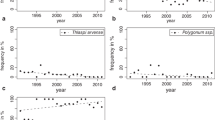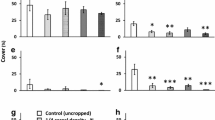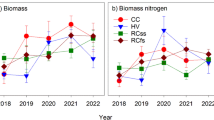Abstract
During the period 1993–1997, at six contrasting sites located throughout England, two successive cereal test crops were grown both with and without nitrogen fertiliser after three or five years of set-aside or after continuous arable cropping. Vegetation during set-aside included natural regeneration and perennial rye-grass (Lolium perenne) with or without white clover (Trifolium repens), managed by mowing on one or more occasions per year. Establishment of the successive cereal test crops after destruction of the set-aside was generally not a problem. Fertile tiller numbers were increased by inclusion of clover in the set-aside cover or application of inorganic nitrogen. The presence of couch grass (Elytrigia repens) or volunteer cereals in the set-aside covers provided alternative hosts for take-all (Gaeumanomyces graminis) and eyespot (Pseudocercosporella herpotrichoides) and take-all caused some yield reductions in following cereal crops. Management during the set-aside period significantly affected grain yields of the subsequent cereal crops in the majority of the site-year combinations. However, these effects were not as large as would be expected after traditional break crops and were frequently masked by the application of nitrogen fertiliser. Mean yields increased by 80% due to the application nitrogen at the optimum rate compared to nil nitrogen. Most of the effects of set-aside treatment on grain yield were shown to be attributable to soil mineral nitrogen content, but at some sites, infections by take-all or eyespot also accounted for some of the variation. There were no effects of pests that could be related to treatment. The presence of sown clover during the set-aside period had the most consistent effect across sites, affecting tiller populations, grain yield and grain quality of cereal crops. At some sites, establishing a sown cover during the set-aside period, or cutting the cover more than once a year, improved grain yield and quality, and reduced the incidence of some specific weeds and disease.
Similar content being viewed by others
References
Acuna P G H and Wilman D 1993 Effects of cutting height on the productivity and composition of perennial rye-grass-white clover swards. J. Agric. Sci. 121, 29–37.
Anon. 1988 Set-aside (SA1). MAFF, London, UK. 20 p.
Anon. 1991 Inside Track, January 1991.
Bacon E T G, Hewitt M V and Shepherd C E 1998 A comparison of management regimes for one-year rotational set-aside within a sequence of winter wheat crops, and growing wheat without interruption 1. Effects of soil mineral nitrogen, grain yield and quality. J. Agric. Sci. 130, 377–388.
Chalmers A G, Bacon E T G and Clarke J 2000 Changes in soil mineral nitrogen during and after three-and five-year set-aside and nitrate losses after ploughing out the five-year covers. Plant Soil (In press).
Chambers B J, Shepherd MA and Vaidyanathan L V 1991 Research and advisory implications of soil mineral nitrogen measurements. Soil Use Man. 7, 66.
Cook S K, Turley D B, Britt C P and Froment M A 1996 Economic assessment of strategies for one-year set-aside. Aspects of Applied Biology 47, Rotations and cropping systems, 293–300.
Dampney, P M R and Salmon S 1990 The effect of rate and timing of late nitrogen applications to breadmaking wheats as ammonium nitrate or foliar urea-N, and the effect of foliar sulphur application. I effect on yield, grain quality and recovery of nitrogen in grain. Aspects Appl. Biol. 25, 229–241.
Forche T 1991 Changing vegetation and weed flora during setaside and afterwards. Proceedings of Brighton Crop Protection Conference, Weeds. 377–386.
Harrison R 1995. An investigation of the relationship between soil mineral nitrogen in the autumn or spring and optimum nitrogen rate for winter cereals. Soil Use Man. 11, 186–192.
Powlson D S, Stockdale E A, Jarvis, S C and Shepherd M A 1994 A review of nitrogen mineralisation in UK agricultural soils. MAFF, London, UK. 134 p.
Shepherd M A 1993 Measurement of soil mineral nitrogen to predict the response of winter wheat to fertiliser nitrogen after applications of organic manures or after ploughed out grass. J. Agric. Sci. 121, 223–231.
Sylvester-Bradley R, Grylls J P and Roebuck J F 1985 Methods for measuring cereal crops. Aspects of Applied Biology 10 Field Trials Methods and Data Handling, 213–239.
Turley D B, Phillips M C, Clarke J H, Raw K A, Jones A E, Hill P E, Froment M A and Mills A R 1994 Development of flora during three years of set-aside, and weed levels in a following wheat crop. Aspects of Applied Biology 40, Farming under CAP Reform, pp. 435–442.
Turley D B, Phillips M C, Clarke J H, Raw K A, Jones A E, Hill P E, Froment M A and Mills A R 2000 Weeds after three and five year set-aside. Annals Appl. Biol. (In press).
Wilson WS, Moore K L, Rochford A D and Vaidyanathan L V 1996 Fertiliser nitrogen addition to winter wheat crops in England: comparison of farm practices with recommendations allowing for soil nitrogen supply. J. Agri. Sci. 127 11–22
Author information
Authors and Affiliations
Rights and permissions
About this article
Cite this article
Smith, J., Cook, S., Mills, A. et al. The effect of three or five years of set-aside on the husbandry and grain yield of subsequent cereal crops in the UK. Plant and Soil 225, 279–297 (2000). https://doi.org/10.1023/A:1026531528082
Issue Date:
DOI: https://doi.org/10.1023/A:1026531528082




